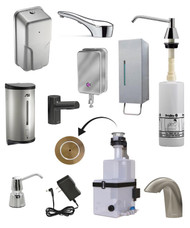Types of Soap Dispensers
In commercial restrooms, every detail matters—especially when it comes to hygiene and user experience. Soap dispensers are one of the most essential fixtures, yet their impact is often overlooked. Whether you manage an office building, restaurant, school, or any other public space, selecting the right soap dispenser can elevate cleanliness, reduce maintenance costs, and even enhance your restroom’s overall aesthetic.
In this blog, we’ll dive into the various types of commercial soap dispensers, exploring their unique features, benefits, and how to choose the best option for your needs. From touch-free models to refillable manual options, understanding these choices will help you create a more hygienic and efficient environment for all. Let’s get started!
Why Soap Dispenser Types Matter
Soap dispenser types matter because they influence hygiene, user experience, maintenance efficiency, and cost. Touchless models reduce germ spread, while manual options can be more budget-friendly. Dispensers compatible with bulk refills lower costs, while cartridge systems simplify maintenance. The right choice also impacts durability and aesthetics, ensuring your restroom meets the needs of users while maintaining a clean, professional look.
Types of Soap Dispensers: Manual vs Automatic
Automatic and manual soap dispensers differ primarily in their operation, hygiene benefits, and maintenance needs. Automatic dispensers use motion sensors to dispense soap without physical contact, reducing germ transmission and enhancing hygiene—ideal for high-traffic or healthcare settings. They often offer a sleek, modern appearance but may require batteries or power sources, adding to maintenance complexity.
Manual dispensers, on the other hand, require users to press a lever or pump to release soap. They are typically more cost-effective, easier to install, and do not rely on power, making them a practical choice for smaller businesses or low-traffic areas. However, they involve more physical contact, which can be less hygienic in public settings. The choice between the two often depends on the balance between budget, user experience, and the hygiene standards of the facility.
Installation Types
When choosing a commercial soap dispenser, the installation type is an important consideration, as it impacts functionality, space usage, and aesthetics. Here’s a breakdown of the three main types:
Wall-Mounted Soap Dispensers:
These are affixed to walls, saving countertop space and offering a clean, uncluttered look. They’re commonly used in high-traffic areas like public restrooms, as they’re easy to access and keep surfaces clear. Wall-mounted dispensers come in both manual and automatic options and are ideal for facilities aiming to maximize space efficiency.
Deck-Mounted Soap Dispensers:
Installed directly on sinks or countertops, deck-mounted dispensers provide convenience by keeping soap close to the faucet. They’re often found in upscale or modern restrooms, as they contribute to a sleek, integrated design. These dispensers may require more precise installation and maintenance, particularly if they use refillable soap reservoirs located beneath the countertop.
Countertop Soap Dispensers:
Freestanding dispensers placed on countertops are a flexible option that doesn’t require installation. They’re perfect for small restrooms or temporary setups and are easy to move or replace. However, they can take up valuable counter space and may not provide the polished look of mounted options. They are also more prone to being knocked over or misplaced.
Each installation type caters to different needs, and the best choice depends on your space, traffic volume, and design preferences.
Soap Types
The type of soap used in a dispenser significantly affects user experience, hygiene, and maintenance. Here's an overview of the three main soap types:
Liquid Soap:
Liquid soap is the most traditional option, offering thorough cleaning with a thick, viscous texture. It’s widely compatible with various dispensers and comes in antibacterial and moisturizing formulations. However, it typically requires more water to rinse off and can be slightly messier, especially in high-traffic areas, as spills or drips are common.
Gel Soap:
Gel soap is similar to liquid soap but often thicker and designed for specialized purposes, such as industrial settings where heavy-duty cleaning is needed. It’s ideal for removing grease or grime and is compatible with dispensers in workshops, kitchens, or outdoor facilities. While effective, gel soap may not be necessary for standard handwashing in commercial restrooms.
Foaming Soap:
Foaming soap has gained popularity for its luxurious feel and efficient use. Dispensers mix liquid soap with air to produce a foam, which spreads easily and rinses off quickly, reducing water usage. Foaming soap is cost-effective since it uses less soap per wash and is often perceived as more upscale, making it a favorite for offices, restaurants, and high-end venues. However, it requires specific dispensers designed for foam formulations.
Choosing the right soap type depends on the setting, user preference, and your goals for efficiency, cost, and cleanliness.
Refill Types
Refill types for soap dispensers impact maintenance convenience, cost, and sustainability. Here’s a breakdown of the common refill options:
Bulk Refill/Top Fill:
This type allows you to pour soap directly into a built-in reservoir, often from a larger, cost-effective bulk container. It’s economical and reduces plastic waste but requires careful handling to avoid spills or contamination. Top-fill dispensers are especially convenient for staff, as they allow refilling from above the counter without removing components.
Cartridge Refill:
Cartridge systems use pre-filled, sealed soap cartridges that snap into the dispenser. These are hygienic and quick to replace, minimizing the risk of contamination. While they simplify maintenance and ensure consistent dosing, cartridge systems tend to be more expensive and generate more plastic waste unless recyclable or refillable cartridges are used.
Bottle Refill:
Bottle refills are similar to cartridge refills but may use proprietary bottles designed for specific dispensers. These bottles are easy to swap out and ensure mess-free operation. Like cartridges, they are convenient but can be costly and less eco-friendly if the bottles are single-use.
Multi-Feed Systems:
Multi-feed systems connect multiple dispensers to a centralized soap reservoir, allowing several units to be refilled simultaneously. This system is ideal for high-traffic areas, as it reduces the frequency of refills and maintenance time. While efficient for large facilities, initial setup and equipment costs can be higher.
The right refill type depends on your priorities—whether it’s cost-effectiveness, ease of use, sustainability, or suitability for high-traffic environments.
Soap Dispenser Materials
The material of a soap dispenser significantly affects its durability, appearance, and suitability for specific environments. Here’s a breakdown of common materials used in soap dispensers:
ABS Plastic:
ABS plastic is lightweight, affordable, and resistant to impact and corrosion, making it a popular choice for high-traffic restrooms. It’s available in a variety of colors and finishes, but it may not have the premium appearance of metal options and can show wear over time in harsh environments.
Brass:
Brass dispensers are highly durable and resistant to rust, offering a classic and upscale look. They’re often used in luxury or high-end settings. Brass can tarnish over time but is easily polished to maintain its appearance. It’s typically more expensive than plastic or steel options.
Chrome-Plated:
Chrome-plated dispensers are visually striking with their shiny, reflective finish. They’re often made of brass or zinc underneath, with a chrome coating for added durability and aesthetic appeal. While resistant to rust and corrosion, chrome plating can show fingerprints and smudges, requiring regular cleaning.
Die-Cast:
Die-cast dispensers are made by casting metal into a mold, resulting in a solid and durable product. They’re often used in commercial or industrial settings due to their robust construction. While heavier and more durable, they may lack the sleekness of stainless steel or chrome finishes.
Polyethylene:
Polyethylene is a type of plastic known for its chemical resistance and durability. It’s commonly used in dispensers designed for bulk soap storage or industrial applications. While highly functional, it tends to have a more utilitarian appearance and isn’t as aesthetically refined as other materials.
Stainless Steel:
Stainless steel is a premium material known for its durability, resistance to rust, and sleek, modern look. It’s a popular choice for high-traffic or upscale environments due to its ability to withstand frequent use and harsh cleaning products. Stainless steel dispensers are more expensive but offer longevity and a professional appearance.
Choosing the right material depends on the environment, budget, and desired aesthetic. For instance, ABS plastic is cost-effective for public restrooms, while stainless steel or brass suits high-end facilities requiring durability and elegance.
Berl's Soap Dispensers
At Berl's, we understand that choosing the right soap dispenser is more than just a purchase—it’s an investment in hygiene, efficiency, and style for your restroom. That’s why we stock an extensive selection of premium brands known for their durability, innovation, and design. Whether you’re looking for sleek, touchless dispensers for a modern office or heavy-duty options for high-traffic facilities, we have something to suit every need.
Our expert staff is here to guide you every step of the way. With deep knowledge of the latest dispenser technologies and industry trends, we can help you evaluate factors like installation type, soap compatibility, maintenance ease, and aesthetics. We don’t just sell products; we offer solutions tailored to your space, traffic, and budget.

